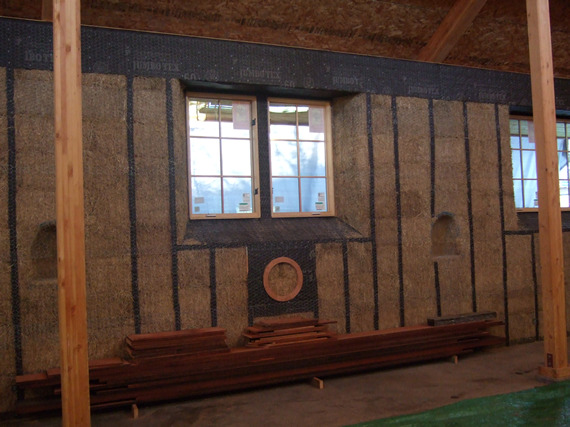
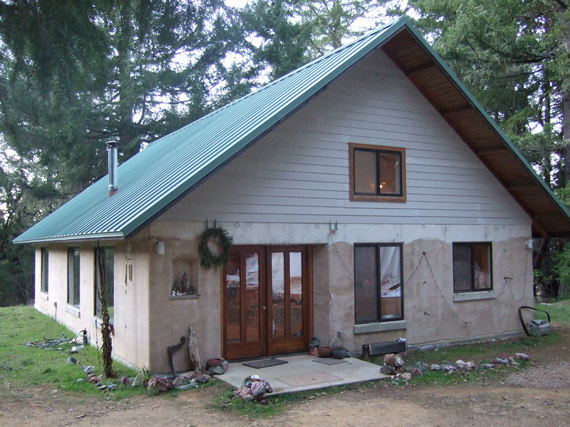
Straw Bale Church, Rammed Earth House
Building with compacted earth is a most ancient building process, yet here you will see a lovely, modern rammed earth house that we built in 2001. To date the walls have required no maintenance. No painting, no scraping, no wet rot, no dry rot. Maintenance free forever!
Building temporary housing with straw and grass is also ancient,
but building a strong, secure, and long-lasting building from straw is relatively new. This Episcopal church has straw bale walls and was built by the congregation of Saint Francis in the Redwoods in Willits CA. The picture at the left is of the unfinished straw bale walls. Note the "truth window" in the center, leaving a view of the wall structure for doubters.
Alternative Building in the Willits Area
Our Willits valley, and Mendocino County in general, has always been a rich source of alternative building. Over thirty years ago residents forced the county to adopt a "Class K" alternative to the standard building codes that was more relaxed for personal structures. Along with rammed earth and
straw bale, we have a number of cob houses, including the first cob house to code in the state. This site focuses on straw bale and rammed earth because of their durability, and speed and ease of construction. Straw Bale and Rammed Earth Buildings
Photodocumentary About Building Our Straw Bale Church
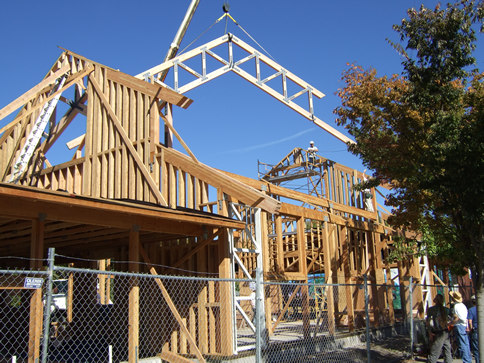
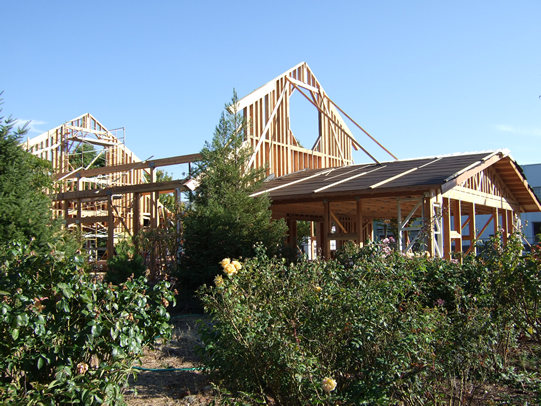
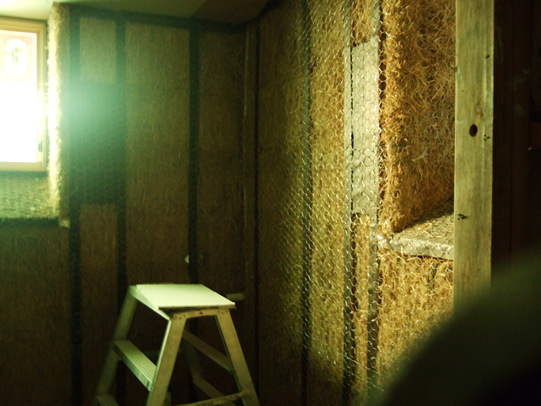
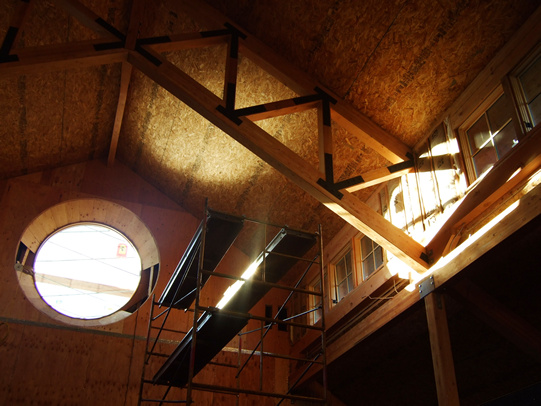
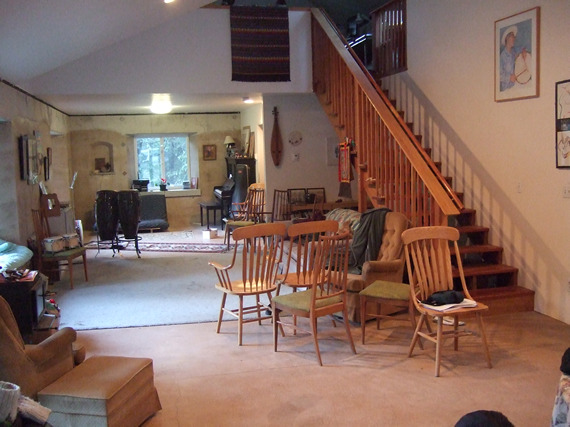
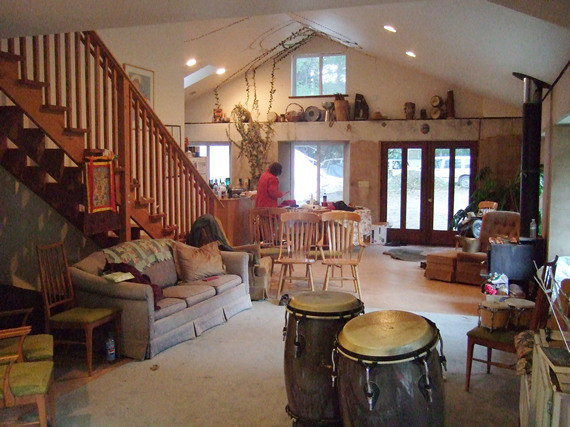
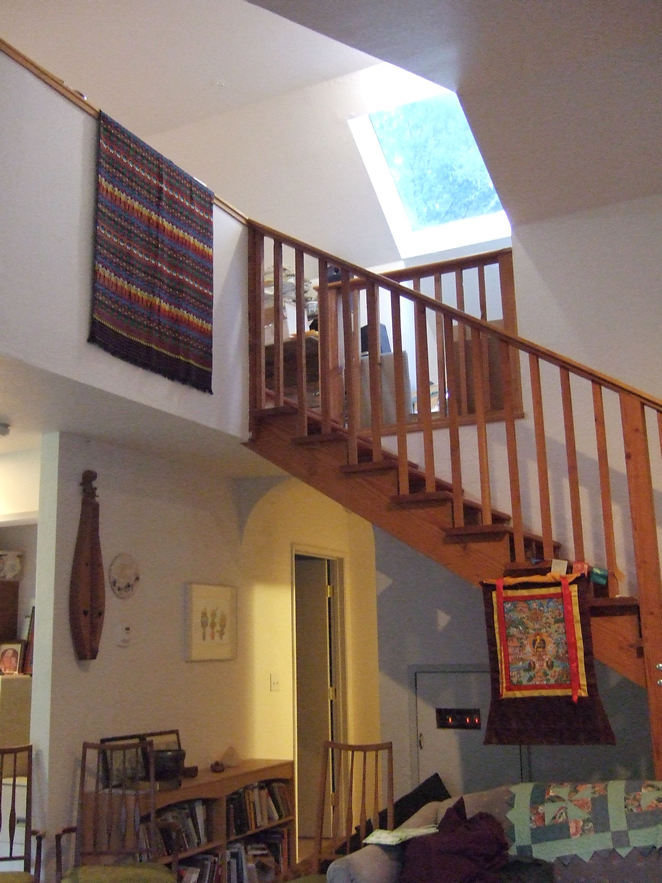
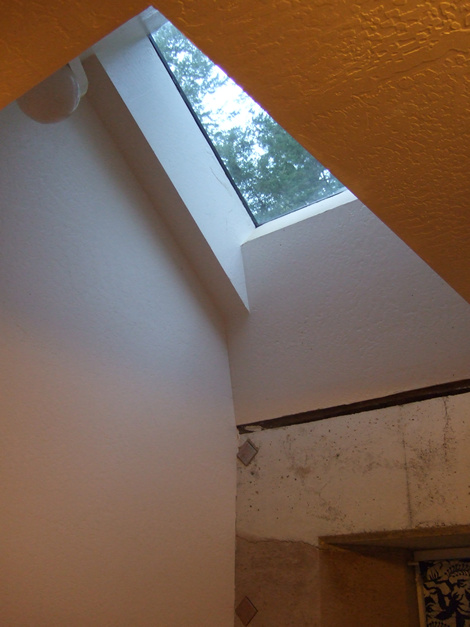
Alternative Housing can be Stylish, Attractive, and Comfortable
This church is right on the corner of the busiest intersection in Willits, yet inside it is quiet even though we have a large circular window facing that intersection.
Both building methods exhibit an unusual sense of restfulness. When our working children visit us they usually sleep a lot; because it is so peaceful, they can really catch up on their sleep.
Alternative Housing can be Very Safe
- It cost us about $5,000 for the engineering to ensure that our house would easily survive an earthquake of magnitude 8. The walls are 18" thick and essentially stone, many forts are not this well built. I think the best example was waking in the morning in a relaxed and quiet house. I walked into the living room and saw through the picture windows that a 40 mph gale was blowing with rain driven every which way.
I watched it for awhile like an aquarium in reverse, finally deciding I should go outside later to experience this violent storm. Rammed earth and properly plastered straw bale are fully resistant to bugs and vermin, and strong proof against the weather.
-
We built our rammed earth house in 2001 for about $85 per square foot, using the best builders we could find, and putting in quality materials. This was a move-in price. Our church cost about $950,000 to build; this is considered a good price for premium construction.
Where this type of construction really shines is in the the long-term costs - they are much lower. One savings for me is getting at least two weekends a year free - that is what I am saving by not ever having to touch my walls - not paint them, not protect them, nor replace them. The finish on our church has a good track record in Europe, and its color and strength last at least 40 years.
Alternative Housing can be Cost Effective
Rammed Earth Construction
This section is not complete. I will have to scan photos of the construction at some later date. What you have is different views of the house we built. It took six months from start to move-in. The construction site was usually as quiet as the woods - except ram days which were still quieter than most building sites. It weighs something like 250 tons and in a major earthquake will float like a houseboat. The roof is directly connected to the walls every two feet. The interior partitions are standard wood stud and wall board. The acoustics are excellent, although it is a hard house to speak secrets in.
Hot summer days are the most impressive. It is wonderful to watch someone walk in the door, walk out again, and walk back in.
The temperature difference is impressive. Especially so since we have a very open house with lots of windows and no curtains (we live in the country). On summer days it is hard to see the flame on our gas stove; it is that bright.
Our dog is completely spoiled. He has cool floors to lie on in the summer. With radiant heat in the floor, he has a warm belly all winter. Sodden clothes and muddy boots are no problem, just throw them on the floor and they will be dry the next day, and the mud has turned into dust.
I do no maintenance on the walls. They do not rust, rot, peel, or fade. They are proof against insects - termites are totally frustrated. Ants have yet to figure out a way in.
No siding to replace, ever. No wet rot or dry rot, ever. It is a profoundly anti-fungal environment - pretty dry but not chafing. I expect someone's (hopefully my) great-grandchildren
will be arguing over who moves in.
We considered doing a straw bale house - I would say it is the most popular alternative building method in Mendocino County.
Most of the straw bale houses ever built are still standing, sometimes a hundred years old. Yet we rejected it because it is not a permanent structure. Probably 100 to 200 years from now it will be gone.
Yet we decided not to build a rammed earth church mostly because it must be kept heated all the time, and we at the time did not think we would be using the church that much.
It also has excellent sound insulation, which is crucial for our downtown location.
Straw Bale Construction
In California we can get rice straw from the Central Valley. The high silica content of rice straw makes it particularly mold resistant. One rice grower has a second business providing highly compressed, standard-length bales that have been conditioned for a year. This allowed us to place almost all the bales in one work weekend.
While loose straw is quite inflammable, compressed straw is quite resistant to fire. Encasing the bales in plaster makes them pretty fireproof.
My research so far has only uncovered two other straw bale churches in North American, and perhaps the world. This is an excellent renewable building method.
The straw in our walls is not load-bearing, that is, it does not hold up the church much, the wood frame does this.
We do have at least one example in Mendocino County of a house built with walls made completely of hay. The windows and doors are framed in by the bales, and the bales support the roof very well.
Resource Management
We are running out of trees to build houses with. They are better used in other venues. They crack, they rot, and they dry out.
We can drastically lower the amount of wood used in a house while making it better and longer lasting. For the church we did not need much fiberglass insulation or any vapor wrap.
In both structure the walls are chemically inert. Both have slab concrete foundations that have to be made more comfortable, but are proof against any type of vermin.
Bill and Betsy Bruneau
18001 Shafer Ranch Road, Willits, CA 95490-9626 USA
Website:www.bbruneau.com
email: bbruneau@bbruneau.com
Copyright 2007-2020, William Bruneau